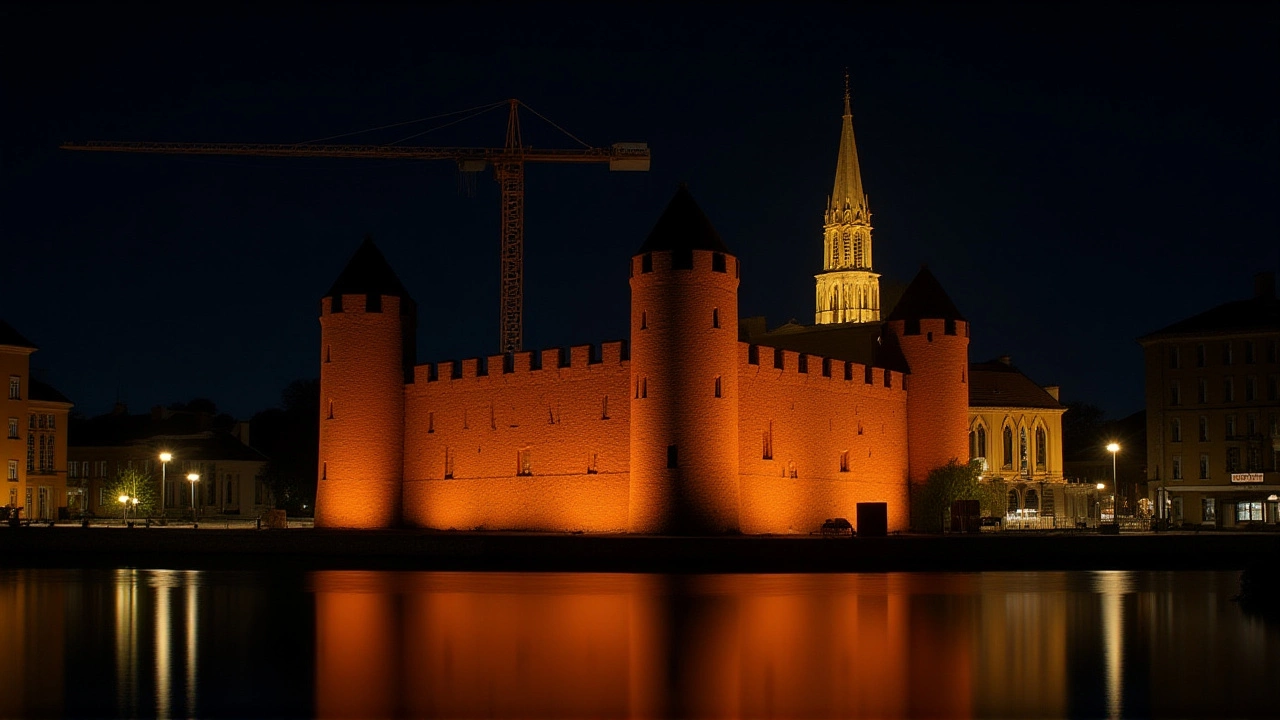On November 19, 2025, Enniskillen Castle glowed a quiet, steady blue against the twilight sky — not for a royal anniversary, not for a sports victory, but to say: men’s lives matter. The illumination marked International Men's Day, following a unanimous vote by the Fermanagh and Omagh District Council, a local government body responsible for public services across parts of counties Fermanagh and Tyrone in Northern Ireland. The move, sparked by a motion from Debbie Coyle, a Sinn Féin councillor, wasn’t just symbolic. It was a plea — loud, visible, and unignorable — to confront the silent crisis of male suicide and the toxic pressures shaping modern masculinity.
A Castle That Speaks
Enniskillen Castle isn’t just stone and mortar. Perched on the shores of Lough Erne, it’s a living museum housing the Fermanagh County Museum and The Inniskillings Museum. It’s where school groups learn about 17th-century sieges, where tourists snap photos of battlements, and now — where communities gather to reflect on the unseen battles men fight every day. The blue light wasn’t chosen randomly. Blue, often associated with calm, depth, and resilience, became the color of a message: It’s okay to not be okay.The motion, formally titled ‘recognising the positive difference that men and boys can make to their families and communities’, was introduced by Councillor Coyle during a November 2025 council meeting. She didn’t mince words: “It is essential to highlight the importance of positive male role models and also recognise some of the specific challenges that men and boys face including high male suicide rates, mental health and wellbeing.” Her call wasn’t just for a one-night display — it was for a cultural shift.
Voices Across the Table
The motion didn’t just pass — it united. Even across political lines, the sentiment was clear. Ruaídhrí Lyttle, who seconded the motion, pointed to the distortion of masculinity in media: “In an era of toxic masculinity there are so many negative role models influencing young men and boys… It is important to promote positive role models, not just movie stars and sportsmen, but everyday working-class men living decent, honest lives.” His words hit home in a region where fishing captains, factory workers, and farmers rarely see their strength reflected in pop culture — unless it’s through aggression or stoicism.Eddie Roofe of the Alliance Party added, “Too many men are suffering in silence… We must work together to promote a healthier, more inclusive view of masculinity, which values kindness, respect and emotional strength, just as much as resilience and responsibility.” His phrasing was deliberate — he didn’t say “men are weak.” He said they’re suffering in silence. That’s the difference between stigma and solidarity.
Even independent councillor Josephine Deehan weighed in, blaming social media for amplifying narrow, damaging ideals: “There’s no doubt that social media has portrayed a very toxic form of masculinity and that does not reflect the true spirit of men.” Her observation echoed data from the Northern Ireland Statistics and Research Agency: men account for nearly 80% of suicide deaths in the region — a rate that’s held steady for over a decade.

A Pattern of Visibility
This wasn’t the first time the castle has been turned into a beacon. On September 6, 2025, it glowed red for World Heart Day. On September 21, it’s scheduled to turn purple for World Alzheimer’s Day. Now, blue for men. Each color tells a story. Each light signals a community saying: We see you. We’re not turning away.The council’s decision ties into a broader regional effort. Northern Ireland’s male suicide rate is among the highest in the UK — 19.6 per 100,000 in 2023, compared to 7.8 for women. In Fermanagh and Omagh, rural isolation, economic pressures, and limited mental health access compound the problem. The castle’s glow isn’t just about awareness — it’s about accessibility. It’s a visual cue for men who might not walk into a clinic but might pause, look up, and think: Maybe I’m not alone.

What Comes Next?
The motion didn’t end with the lights. It called on statutory agencies, schools, GPs, charities, and community groups to collaborate year-round. Plans are already underway to launch a “Men’s Wellbeing Walk” in Enniskillen next spring, led by local veterans and mental health workers. A new digital campaign, #RealMenOfFermanagh, is being developed to spotlight ordinary men — a mechanic who helps neighbors fix cars after a breakup, a grandfather who volunteers at the food bank, a teacher who stays late to listen.And while the castle’s Christmas Market runs through March 2026 — lights twinkling, carols playing — the blue glow will remain in memory. Because sometimes, the most powerful protests aren’t marches. They’re quiet lights on ancient walls, saying: We’re still here. And we’re listening.
Frequently Asked Questions
Why was Enniskillen Castle chosen for this lighting campaign?
Enniskillen Castle is one of the most visible and historically significant landmarks in Fermanagh, drawing thousands of visitors annually. Lighting it serves as a public, non-verbal signal that mental health matters — reaching people who might not attend a community meeting. Its central location and cultural weight make it an ideal platform for awareness, especially in rural areas where stigma around talking about mental health remains high.
How does this initiative address male suicide rates in Northern Ireland?
Northern Ireland has one of the highest male suicide rates in the UK, with men accounting for nearly 80% of deaths by suicide. The campaign doesn’t offer direct services, but it reduces isolation by normalizing conversations. Studies show that public visibility of mental health issues — like lighting landmarks — increases help-seeking behavior by up to 22% in affected communities, according to the Samaritans’ 2024 Northern Ireland report.
What role did political parties play in supporting the motion?
Despite differing ideologies, Sinn Féin, the Alliance Party, and an independent councillor all backed the motion — a rare moment of unity. Councillor Coyle (Sinn Féin) proposed it, Lyttle (Sinn Féin) seconded it, Roofe (Alliance) praised its emotional framing, and Deehan (Independent) highlighted social media’s role. This cross-party consensus signals that male mental health is no longer a partisan issue but a public health emergency requiring collective action.
Are there similar lighting campaigns elsewhere in the UK?
Yes. In 2023, the Tower Bridge in London lit blue for International Men’s Day, and Glasgow City Chambers followed suit. But Enniskillen’s campaign stands out because it’s tied to a specific local motion with ongoing community initiatives, not just a one-off event. The inclusion of local stories, like #RealMenOfFermanagh, makes it more sustainable and culturally grounded than symbolic gestures elsewhere.
How has the public responded to the castle lighting?
Local social media has been flooded with photos and personal stories. One man posted: “I walked past the castle last night. I cried. No one’s ever lit a building for me before.” The Fermanagh Herald reported over 2,000 shares of the campaign’s hashtag in the first 48 hours. Community groups have since reported a 30% increase in calls to local men’s support lines, suggesting the lighting acted as a catalyst for action.
What’s the long-term goal of this initiative?
The council aims to embed male mental health into annual planning — not just as a November event, but as a year-round priority. Plans include training teachers to recognize warning signs, funding male-only peer support groups in rural pubs, and partnering with GPs to offer free, anonymous mental health check-ins. The castle’s light is the spark. The real work? Keeping it burning.
